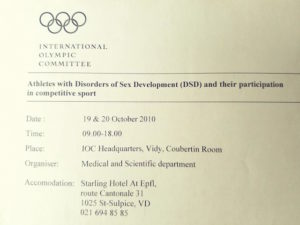Our E.D. on Lobbying the IOC on Behalf of Intersex Women Athletes
In October, 2010, our E.D. Hida Viloria participated, by invitation, in the International Olympic Committee (IOC)’s meeting, “Athletes with Disorders of Sex Development and their participation in competitive sport,” held in Lausanne, Switzerland (see below).

The meeting was the second gathering of experts convened in the wake of Caster Semenya’s gender verification testing media storm, to deliberate the IOC’s proposed regulations for intersex women athletes. After reported proposals after the first IOC meeting, held in Florida in January 2010, that: “Athletes who identify themselves as female but have medical disorders that give them masculine characteristics should have their disorders diagnosed and treated,” Viloria lobbied for the following demands stated in OII’s February 2010 Petition to the IOC:
1. That the International Olympic Committee (IOC) abandon its demands that female athletes with intersex variations have their variations diagnosed and treated.
2. That the IOC allow the above mentioned athletes, known as intersex women, to compete as females without having to undergo diagnosis or “treatment.”
3. That the IOC, the press, and medical practitioners refer to females with intersex variations as “women,” or “intersex women,” and not “women with disorders of sex development.”
The petition received impressive academic support, and Viloria was consequently invited to participate in the second meeting of experts, which she reported on to us below.
Although many meeting attendees supported demands #1 and #2–to cease targeting female athletes with intersex variations for “diagnosis and treatment,” and to allow them to compete as women as is–athletes and, in turn, top IOC and IAAF officials, opposed them. They pushed for a testosterone based policy to address athletes’ complaints, despite ample discussion that there was no evidence to support such a policy. I then lobbied, with support from several other attendees, that if these policies were to be adopted they should be applied uniformly to all female athletes in order to ensure fairness. This suggestion too, was opposed. I was able to successfully lobby for demand #3–to abandon the use of the term “disorders of sex development”(DSD) to describe athletes–with many in agreement that the term is unnecessarily stigmatizing. I clarified that “intersex” is not accurate either as there are intersex women with CAIS, as discussed at the meeting, whom are allowed to compete as is and are not targeted by the new policy proposals. Thus, the phrase “women with hyperandrogenism,” a term referring to women with high, naturally occurring functional testosterone levels–the specific population being impacted by policy proposals–was adopted for use in the policy drafted by the end of the meeting. I later fought, successfully, against attempts that the newly drafted policy be inaccurately described as a ‘consensus statement,’ as myself, and others, had highly opposed its content.
****
